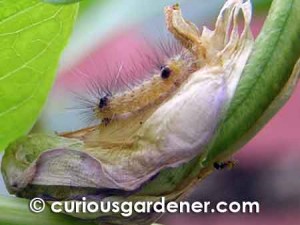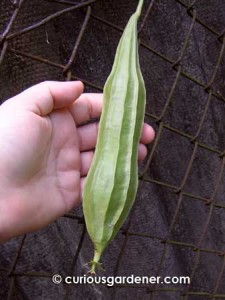One thing I don’t particularly enjoy about gardening is discovering what creatures are feasting on my plants. Seeing holes or spots or squiggles on my plants’ leaves makes my heart falter a little, and then it’s with no little apprehension that I take a closer look.
Here’s how it may begin: a leaf with a big dry brown patch on it – right next to another leaf that’s even browner and drier than the first. I know that means that something has eaten away the nice spongy layer of chlorophyll…
I’m chicken, so this time I used the cutters to lift the leaf.
And I’m so glad I did that, because this is what was underneath:
… freshly hatched caterpillars!
And these were not just any caterpillars, but the hairy ones!
What I don’t like about these little fellas is that they’re dangerous, and they move really fast! They’re the Speedy Gonzalez of caterpillars as far as I’m concerned. If you’ve ever stopped to observe one of them, you’ll understand what I mean. When they’re not eating, they’re pretty much racing off to find their next meal. I must try to catch one on film to demonstrate…
In my home, we’ve been calling these caterpillars “itchy buluh” since we were kids. In the Malay language, buluh means “hair” so I guess you can figure the explanatory nature of the name. As a matter of fact, most creatures that have spines or scales or other protective or defensive attributes flaunt them as a warning to possible predators. So we learned that the weird, bristly caterpillars were to be avoided, and the lesson stuck for life.
Being the curious creature I am, I looked up the properties of these fuzzy critters, and discovered that the hairs can be either venomous or fragile. The venomous type can secrete the poison (normally histamines) upon contact or when broken. The fragile, non-venomous type simply fragment easily and penetrate skin or clothing, causing irritation. The hairs retain their irritating properties (pun intended) even after they have been discarded, so beware old cocoons, discarded larval skins and any other areas the caterpillars may have had contact with. Now that I know all this, I wear gloves to handle any plant I’ve seen the caterpillars on. It explains why my skin occasionally gets irritated after working in the garden.
If you’ve been afflicted by the hairy caterpillar, first use adhesive tape to strip off as many fragments possible from your skin and clothing (you likely won’t be able to see them – they’re that tiny). Next, try analgesic cream or antihistamines, and if it’s really bad, go to the doctor for treatment.
So, I thought those hairs would be a really good defense against predators, but then I came across this article at the Bird Ecology Study Group site showing how a smart bird got around this. I guess in nature, there’s always something else bigger and smarter that can have you for lunch!
Somehow, that thought makes me happy, because the *censored* hairy caterpillars have been having a feast in my garden this last week. My poor loofah vine has been virtually stripped of leaves, and I wonder what’s going to happen to the lone fruit developing on it. I also daren’t touch my long bean plants without wearing gloves because the *bleep* caterpillars are there pretty often. May many more birds learn the trick of eating these irritating creatures!
© 2010 curiousgardener.com All rights reserved.














